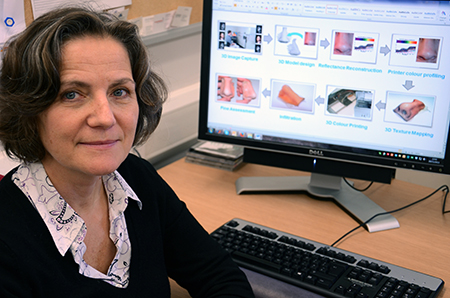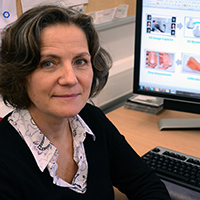 Dr Sophie Wuerger: “This science is at an early stage, but the advantages of 3D printing for medicine are enormous”
Dr Sophie Wuerger: “This science is at an early stage, but the advantages of 3D printing for medicine are enormous”
Researchers at the University of Liverpool are developing synthetic skin that can be produced on a 3D printer and matched to a person based on their age, gender and ethnic group.
3D printing is a new science, thought to have significant potential for developments in medicine. Printers are relatively cheap and can be programmed with almost any variation of designs – all without the need for a donor or a factory producing artificial parts. Efforts at producing skin, however, have so far failed to produce a product that looks realistic enough to be indistinguishable from the real thing.
Natural appearance
Working alongside colleagues at the University of Manchester, Liverpool researchers are now developing 3D image processing and skin modelling techniques that can copy a person’s skin so that it appears natural, whatever light it is shown in.
While it is possible to print synthetic skin in one tone, this does not reflect the diversity of the surface which in real life will be patterned by freckles, veins and wrinkles. People walking between daylight and artificial light also take on a different shade, so any synthetic skin has to produce the same effect.
The first strand of the project will be to perfect 3D camera technology and subsequent image processing that can almost exactly match an individual’s skin tone and skin texture under varying light sources. This will be carried out on an individual basis so that each person’s synthetic skin is bespoke.
The researchers will also find ways of taking 3D images of skin types of hundreds of people in order to build up a database which can be used more generally. This bank would then be used in more remote areas or in countries where access to calibrated 3D cameras is difficult. 3D printers, however, are relatively cheap so with access to a bank of skin types and a printer, medics could still produce a close match of skin type chosen from a large database of designs.
Enormous advantages
Dr Sophie Wuerger from the Perception Group in the University’s Institute of Psychology, Health and Society said: “This science is at an early stage, but the advantages of 3D printing for medicine are enormous.
“The human visual system is extremely sensitive to small distortions in skin appearance, so making a convincing synthetic version will be essential whether this technology is used for emergency or cosmetic medicine.”
The project which will last for three years and is funded by the Engineering and Physical Sciences Research Council (EPSRC), is led by Dr Wuerger, in collaboration with Dr Chris Sutcliffe, School of Engineering and Professor Julian Yates, School of Dentistry, University of Manchester.
